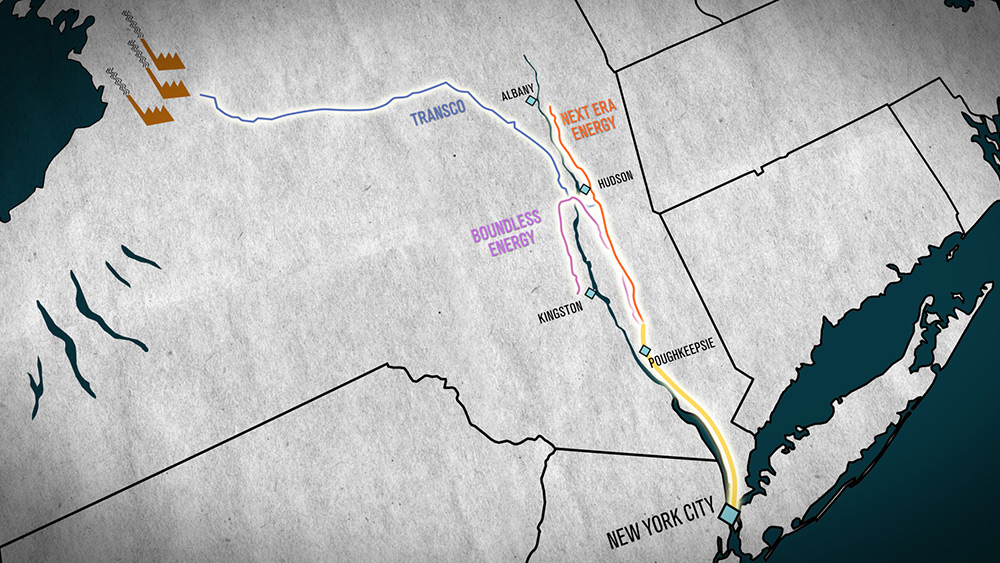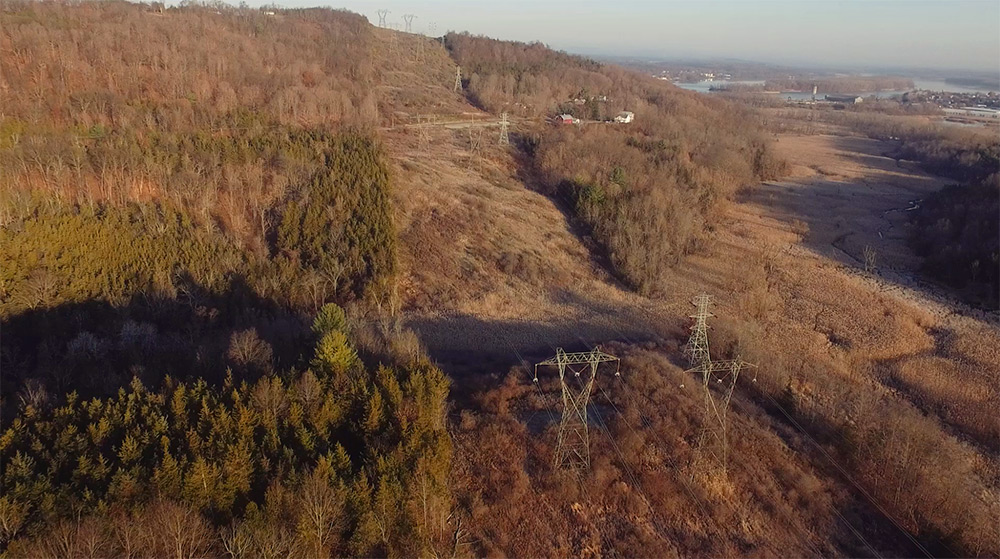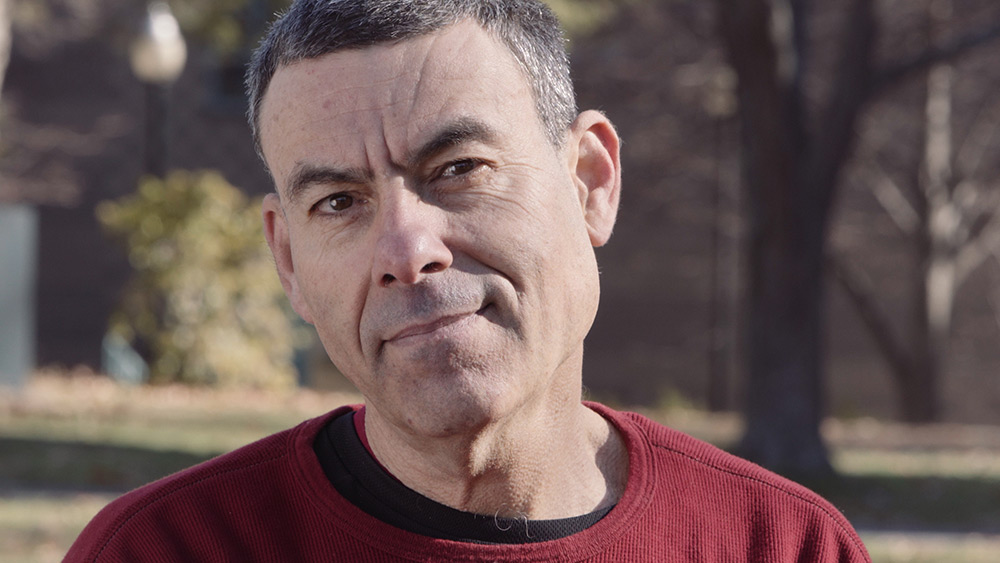HIGH VOLTAGE / DARK SHADOW
NEW ELECTRICAL TRANSMISSION LINES SOLD ON FALSE PRETENSES
Story by Jon Bowermaster
Film by Chris Rahm & Devin Pickering
ill Yandik, Livingston town councilman and farmer stands in a dirt lane leading through the Columbia County land his family has farmed for the past one hundred years.
Pointing skyward towards towering transmission lines that cut diagonally across his family’s farm, he acknowledges they have been here since before he was born. “I grew up under transmission lines and they’ve run through our farm for three generations,” he says. “But the idea that they need to be replaced, doubled in size, which is what’s been approved by the state, is a 20th century solution for a 21st century problem.”
The specter of these giant, high-voltage transmission lines has cast a dark shadow over the Hudson Valley.
– Ned Sullivan, Scenic Hudson
The alleged problem? According to utility owners and Governor Andrew Cuomo’s Public Service Commission, there are only a few days a year where New York City is at risk of a brown-out, requiring more electricity than it currently has, mostly during the dog days of August, when everyone’s air conditioners are cranked high.
Utility companies in central and western New York propose to spend $1.2 billion stringing new lines of massive towers to deliver that needed electricity. Despite the protests of thousands of Hudson Valley residents who fought the proposal for the past two years on December 18, 2015, the PSC, gave the project at least a “next step” green light. It must now “write” a specific order for the project, which is expected sometime in 2016 with new lines being installed as early as 2019.
Transmission Line Towers run through residential neighborhoods in Dutchess County.
There is nothing small about this proposed project. The new lines will climb to one-hundred-and-thirty-feet tall and follow 22 proposed corridors. Farm fields and orchards will be bisected, scenic landscapes and tourist destinations visually marred. The debate whether to build or not to build pits green activists against powerful Albany lobbyists. Ultimately the primary point of contention was less about the aesthetics of essentially running a giant extension cord from upstate New York to NYC and more about whether or not any additional electricity was even necessary.
When in his state of the state address in January 2012, Governor Andrew Cuomo first proposed the concept of a New Energy Highway – a massive rethink of how New York State is powered – the idea sounded like a win-win for the states’ energy future. He later upped the ante by signing on to the state goal of obtaining 50 percent of its energy from what we today regard as alternative sources – wind, solar, geothermal, hydropower – by 2030.
In our reporting of this ‘Hudson, A River at Risk’ series, energy delivery systems – transmission lines, natural gas pipelines, trains, barges and pipes carrying crude oil – have emerged as one of the biggest combined threats to the environmental health of both the Hudson River and Valley. The threat of spills, leaks, explosions, fires and aesthetic disruption is constantly being weighed against the goal of moving away from a fossil fuel-based energy system.
Since his 2012 announcement, the Governor’s administration has worked to flesh out the details of how to make that transition to a cleaner energy future, with the hopes of keeping everyone from utility owners to green advocates happy, though their respective goals are radically different. If you own a power plant, you want to keep it working at the highest volume possible and spend as little as possible to expand your reach. If you’re an environmental group you want to slow old, dirty, fossil fuel-based energy providers and seek new solutions to problems created by an aging power grid; you want to see more and more wind, sun, water and conservation added into the mix of energy providers.

Building new transmission lines, this giant extension cord running across the state, is one of the delivery systems still under consideration. Estimates total the cost of the project at more than $1.2 billion, to be paid by rate-payers, and dependent on which utility wins the bid to construct it, could cut a one-hundred-fifty-mile-long path through century farms, historic estates including Frederick Church’s Olana, as many as eighty towns and suburban neighborhoods. This chain of new, one-hundred-thirty-foot-tall towers carry electricity created by aging coal burning and nuclear-fired power plants that many think should be making plans to be shut down rather than fire up.

Those in favor of the new lines argue that during peak energy days in New York City the lines would prove to be more cost efficient. Another study seemed to indicate that the additional electricity to be provided by new transmission lines was actually not necessary and the debate ratcheted higher.
Gidon Eshel, Research Professor of Environmental Physics at Bard College, wrote a peer-reviewed study of the real demand, thus need, for the project. “This is a ludicrous proposal,” he said when we met on the Bard campus. “Our studies show no additional infrastructure is necessary to meet New York City’s peak electricity needs. None.” His study shows that New York City actually has a surplus of electricity and, that conservation would go a long way to growing the surplus while new transmission lines would be “ingenuously designed to reduce efficiency.”

“If you want to stick with the ‘extension cord’ metaphor, it is a giant extension cord disconnected from anything else.”
Eshel suggests delivering electricity across the state is even more antiquated than even Will Yandik proposed: “For a state to commit itself to 19th century energy sources in the 21st century is unconscionable,” he says.
Proponents of the lines, now with the backing of the Governor’s three-person PSC board, contend the new lines are needed to reduce energy costs, relieve congestion and to plan for the future against an aging energy infrastructure.
Ironically, the biggest argument for not building new transmission lines may have also originated in Governor Cuomo’s office. In April 2014 the governor offered up his Reforming Energy Initiative (REV) with the goal of reducing the state’s carbon emissions by creating a new-age power grid that would reward consumers and utilities for conserving electricity and switching to renewable sources, including solar and wind.
Ned Sullivan, President of Scenic Hudson, one of 25 member groups of the Hudson Valley Smart Energy Coalition organized to argue against the transmission lines, states that the REV should be a guide to the future without reverting to building old-school power lines. “The transmission lines, despite overwhelming evidence they aren’t needed, would damage our environment and communities and cost consumers more. Why green light the construction of this outdated technology?”
“The specter of these giant, high-voltage transmission lines has cast a dark shadow over the Hudson Valley,” says Sullivan.
While ultimately the decision to build or not is in the Governor’s hands – he appoints the commissioners of the PSC – the move towards building the new transmission lines doesn’t seem to align with his stated goals of dramatically reducing carbon emissions since the energy created will come from old, fossil-fuel burning and nuclear power plants. But the utilities that own those power plants have employees they don’t want to lay off, have a need to make money for their communities and are campaign donors. In many cases where politicians are relied on to make futuristic energy decisions, they often choose to try and keep everyone happy with some kind of “all of the above” energy policy. (i.e. see President Obama).



